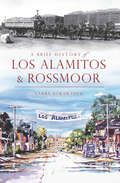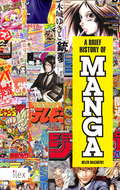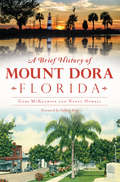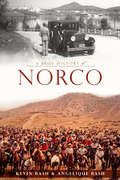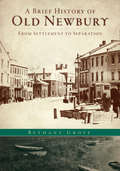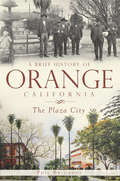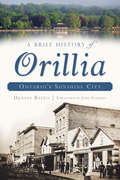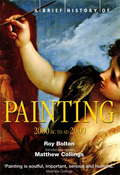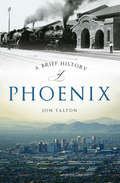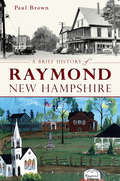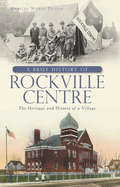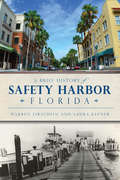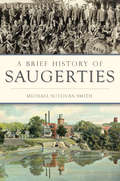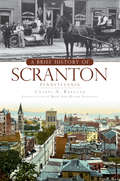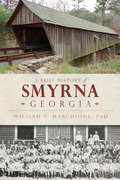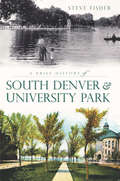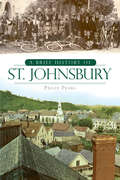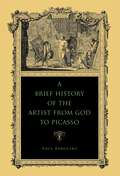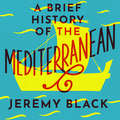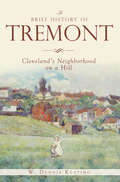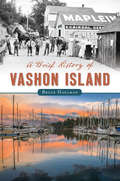- Table View
- List View
A Brief History of Los Alamitos-Rossmoor
by Larry StrawtherThe city of Los Alamitos and the contiguous, unincorporated community of Rossmoor exemplify small-town America amid the populous western Orange County sprawl. Their tree-lined streets, well-kept homes and first-rate schools are reflected in Rossmoor's selection as the No. 1 suburb in California (and No. 9 nationwide) in a 2012 study by Coldwell Banker Realty. The evolution of Los Alamitos from cattle ranches and sugar beet factory town to World War II military town and ultimately into residential neighborhoods took a century. Meanwhile, the planned "walled 'city' of Rossmoor" was created between 1955 and 1961. Despite annexation talk, Rossmoor and "Los Al" coexist apart together, so to speak, on Long Beach's outskirts. Author Larry Strawther traces the histories of these interdependent sister communities, which epitomize the reality in the legend of the Orange County lifestyle.
A Brief History of Manga: The Essential Pocket Guide To The Japanese Pop Culture Phenomenon
by Helen MccarthyManga is more than a genre in the comics field: it is a vital creative medium in its own right, with hundreds of millions of readers worldwide, a host of graphic styles, and a rich history now spanning seven decades. Now for the first time, that history is told by an award-winning expert in the field. Covering topics from Akira to Mazinger Z, this book is fully illustrated throughout, and photos of key creators accompany accessible sidebars and timelines. The text is chronological, telling the story of Manga from its early-20th-century origins to its global dominance. Timelines relate key publications to events in Japanese and World history, and frequent sidebars give short biographies of key creative figures. Answering the key questions of any fan - where did my favourite manga come from, and what should I read next? - this book will open doors to neophytes and experts alike. Fans of manga and anime will: - discover the stories behind their favorite manga creator - be inspired by the history of the medium and its genre - find new manga to read and fall in love with
A Brief History of Manga: The Essential Pocket Guide To The Japanese Pop Culture Phenomenon
by Helen McCarthyManga is more than a genre in the comics field: it is a vital creative medium in its own right, with hundreds of millions of readers worldwide, a host of graphic styles, and a rich history now spanning seven decades.Now for the first time, that history is told by an award-winning expert in the field. Covering topics from Akira to Mazinger Z, this book is fully illustrated throughout, and photos of key creators accompany accessible sidebars and timelines.Answering the key questions of any fan where did my favourite manga come from, and what should I read next? this book will open doors to neophytes and experts alike.
A Brief History of Mount Dora, Florida (Brief History)
by Nancy Howell Gary MckechnieMount Dora is known for its southern charm and New England look, yet its history is just as engaging. The "Festival City" began with the arrival of pioneer families such as the Drawdys, Simpsons and Tremains. In the 1880s, it became a popular destination for Chautauqua events, when visitors gathered beside Lake Gertrude and Lake Dora for educational and cultural enrichment. In the twentieth century, Mount Dora weathered economic setbacks and racial conflict before becoming a premier city of the arts. Today, this beautiful lakefront community welcomes thousands of visitors to its numerous festivals, events and active shopping village. Join authors Gary McKechnie and Nancy Howell as they celebrate the intriguing history of their town.
A Brief History of Norco (Brief History)
by Kevin Bash Angelique BashLegend has it that Rex Clark won fifteen square miles of failed farms, rutted roads and broken water mains in a poker game. Using his wife's newspaper fortune, Clark tried orchards and then poultry. Local hot springs inspired Clark's creation of a giant recreational resort. U.S. presidents and Hollywood royalty sojourned at the fabulous Norconian until the Great Depression hit. The spa was converted to U.S. Naval Hospital #1 during World War II and then a top Cold War missile lab. Norco became a horse-raising enclave while staving off annexation from nearby southwestern Riverside County cities. Today, the city is known nationwide as HorseTown, USA. Join former mayor Kevin Bash and his coauthor daughter Angelique Bash for this engaging trail ride through Norco's colorful past.
A Brief History of Old Newbury: From Settlement to Separation
by Bethany GroffIn the first ten years of its settlement, the town of Newburywitnessed murders, kidnappings, earthquakes and a plague of caterpillars. The century that followed--marked by religious conflict, Indian uprisings and public scandal--proved no less challenging to the early Puritan community.In 1640, Massachusetts Governor John Winthrop noted, "Aspeople increased, so sin abounded." But through the turmoil, Newbury's citizens harnessed the region's abundant natural resources and developed a thriving community. Author Bethany Groff introduces the compelling personalities that shaped the history of Old Newbury up until 1764, when Newburyport received its independence from the mother town. From the scandalous exploits of Dr. Henry Greenland to the courageous and sacrificing acts of founding families like the Emerys, Dummers and Pikes, A Brief History of Old Newbury provides a captivating glimpse into the verve of thisearly New England town.
A Brief History of Orange, California: The Plaza City
by Phil BrigandiOrange, California, a city that started small, but grew big on the promise, sweat and toil of agriculture. Born from the breakup of the old Rancho Santiago de Santa Ana, its early days were filled with horse races, gambling, and fiestas. Citrus was the backbone of the economy for more than half a century, though post-war development eventually replaced the orange groves. Historian, and Orange native, Phil Brigandi traces the roots of the city back to its small town origins: the steam whistle of the Peanut Roaster, the citrus packers tissue-wrapping oranges for transport, Miss Orange leading the May Festival parade, and the students of Orange Union High painting the O and celebrating Dutch-Irish Days. In doing so, he captures what makes Orange distinct.
A Brief History of Orillia: Ontario's Sunshine City (Brief History)
by John Forrest Dennis RizzoLocal author Dennis Rizzo tells the fascinating and diverse history of Orillia, Ontario. First populated by the Huron, Iroquois and Chippewa Nations, Orillia is now a well-loved, year-round recreation destination. Its history is deeply tied to its water. Situated in the narrows where Lake Simcoe flows into Lake Couchiching, Orillia was a gathering place for centuries before Europeans used it to bring furs to market. Sir John Simcoe, first governor of Upper Canada, fostered permanent settlement of the area. A gateway to the Muskoka region, it has been home to lumber, manufacturing, and artistic endeavours. Today, summer cottagers and winter athletes alike enjoy the Sunshine City and its more than twenty annual festivals. Local author Dennis Rizzo tells the fascinating and diverse history of Orillia, Ontario.
A Brief History of Painting: 2000 BC to AD2000
by Roy BoltonThe urge to create pictures of our world has been with us ever since early man daubed a fingerful of pigment on a rock, or used primitive colours to create exquisite images of the beasts he hunted - images so breathtakingly powerful they have never been surpassed, however sophisticated we have become. This book tells the story of what painting has meant to us, and how its role has changed over the centuries. In the crisp, unstuffy commentary on each of 150 landmark works, Christie's art expert Roy Bolton leads us through the development of painting until our own age, where painting as a painterly craft has been overtaken by a proliferation of new forms introduced by contemporary art. To the question, 'Is the death of painting upon us?' the introductory chapter by Matthew Collings, the multi-award-winning TV art presenter, art historian and cultural critic, gives an inspiring answer: 'Painting justifies itself. Rather than pathetically struggling to keep up with the new freak-show culture of videos and installations, painting will only be worth having if it reconnects with its own inner life, where the old and the new are the same.' Roy Bolton's selection takes us from the Ancient World, via the Italian Renaissance, Rococo and Classicism to Impressionism, Modernism and the Contemporary World. Each painting, with its context and artist, is explained in terms designed to encourage us to judge art for ourselves. Written with authority and full of original and helpful insights, this is a history of art for our times. 'While I find it interesting to think about all sorts of art, I prefer painting to any of it. Painting is soulful, important, serious and humane.' Matthew Collings 'We need to de-mystify art by stripping it down to its bare essentials, then rebuilding it ourselves, using our own minds and eyes, without all the pompous clutter.' Roy Bolton
A Brief History of Painting: 2000 BC to AD2000 (Brief Histories)
by Roy BoltonThe urge to create pictures of our world has been with us ever since early man daubed a fingerful of pigment on a rock, or used primitive colours to create exquisite images of the beasts he hunted - images so breathtakingly powerful they have never been surpassed, however sophisticated we have become. This book tells the story of what painting has meant to us, and how its role has changed over the centuries. In the crisp, unstuffy commentary on each of 150 landmark works, Christie's art expert Roy Bolton leads us through the development of painting until our own age, where painting as a painterly craft has been overtaken by a proliferation of new forms introduced by contemporary art. To the question, 'Is the death of painting upon us?' the introductory chapter by Matthew Collings, the multi-award-winning TV art presenter, art historian and cultural critic, gives an inspiring answer: 'Painting justifies itself. Rather than pathetically struggling to keep up with the new freak-show culture of videos and installations, painting will only be worth having if it reconnects with its own inner life, where the old and the new are the same.' Roy Bolton's selection takes us from the Ancient World, via the Italian Renaissance, Rococo and Classicism to Impressionism, Modernism and the Contemporary World. Each painting, with its context and artist, is explained in terms designed to encourage us to judge art for ourselves. Written with authority and full of original and helpful insights, this is a history of art for our times. 'While I find it interesting to think about all sorts of art, I prefer painting to any of it. Painting is soulful, important, serious and humane.' Matthew Collings 'We need to de-mystify art by stripping it down to its bare essentials, then rebuilding it ourselves, using our own minds and eyes, without all the pompous clutter.' Roy Bolton
A Brief History of Phoenix
by Jon TaltonThough the new metropolis is one of America's largest, many are unaware of Phoenix's rich and compelling history. Built on land once occupied by the most advanced pre-Columbian irrigation society, Phoenix overcame its hostile desert surroundings to become a thriving agricultural center. After World War II, its population exploded with the mid-century mass migration to the Sun Belt. In times of rapid expansion or decline, Phoenicians proved themselves to be adaptable and optimistic. Phoenix's past is an engaging and surprising story of audacity, vision, greed and a never-ending fight to secure its future. Chronicling the challenges of growth and change, fourth-generation Arizonan Jon Talton tells the story of the city that remains one of American civilization's great accomplishments.
A Brief History of Raymond, New Hampshire (Brief History)
by Paul BrownScenic sites and a proud community make Raymond the bucolic New Hampshire town it is today. The local cast of characters has its own unique story set in the heart of the Granite State. Local author Paul Brown has mined 250 years of town history, from the early settlement to the post-World War II boom. Search for the truth behind the conflicting stories of how the original Freetown became known as Raymond. Meet legendary locals like Dudley Tucker and dig into local legends like the mystery of Scud Lyman. The stories behind the Great White Rock and even Clint Eastwood connections color the history of Raymond. Join Paul Brown as he charts the remarkable course of Raymond history.
A Brief History of Rockville Centre: The History and Heritage of a Village
by Marilyn Nunes DevlinThe village of Rockville Centre is a suburban haven on Long Island. Beginning in the eighteenth century with families like the DeMotts, this small farming community quickly grew. Ship captains left their families here while they sailed, and the arrival of the South Shore Railroad brought the wealthy from New York City. Residents established churches, schools, restaurants, newspapers, hotels and shops. Some of these, like the English Evangelical Lutheran Church of the Holy Trinity and the Fortnightly Women's Club, are still part of Rockville Centre's vibrant community. As the village continues to grow, the legacy of its past preserves its tight knit atmosphere. Local author Marilyn Devlin presents Rockville Centre's unique history in these pages.
A Brief History of Safety Harbor, Florida
by Warren Firschein Laura KepnerAccording to legend, Spanish explorer Hernando de Soto arrived on the shores of Safety Harbor in 1539 believing that he had discovered the fabled Fountain of Youth. For centuries, the area's natural mineral springs had hosted the Tocobaga people and would later attract early pioneers to west-central Florida. The natural mineral springs drew visitors to bathe in their restorative waters, and in the twentieth century, they were eventually transformed into the world-famous Safety Harbor Resort and Spa, enjoyed by wealthy socialites and professional athletes for decades. Today, the city is best known for its abundance of festivals and the collection of artists, writers, poets and musicians who call it their home--an oasis of calm within bustling Pinellas County. Join authors Warren Firschein and Laura Kepner as they detail the vibrant history of scenic Safety Harbor.
A Brief History of Saugerties (Brief History)
by Michael Sullivan SmithBeginning as a Dutch settlement, Saugerties is scenically positioned between the Hudson River and the base of the Catskills. In 1609, the great explorer Henry Hudson's first mate, Robert Juet, recorded a meeting with Native Americans in the area. In its early days, the land was part of the Kingston Commons, one of the first municipalities in the colonies to be governed by an elected body. The town's history was shaped by industry. In the nineteenth century, bluestone quarries and paper and lead mills drove its economy, and a century later, Saugerties became a commuter town for IBM's plants. Michael Sullivan Smith chronicles the rich history of Saugerties.
A Brief History of Scranton, Pennsylvania (Brief History)
by Cheryl A. KashubaThe intense heat of the steel mills and the clatter of coal-filledlocomotives once filled the streets of Scranton, Pennsylvania. Hardworking immigrants, iron rails, and anthracite coal from beneath the surface of the lush Lackawanna River Valley poweredAmerica's Industrial Revolution, and until World War II, the city reigned as a cutting-edge boomtown. Local journalist Cheryl A. Kashuba chronicles the history of Scranton from the glory days of the Lackawanna Iron and Coal Company and the Dickson Works through the post-Industrial decline and an eventual revitalization of the city. With a deft hand, Kashuba captures the spirit of a proud community and creates a fascinating portrait of the Electric City.
A Brief History of Smyrna, Georgia (Brief History)
by William P. MarchioneThe dynamic city of Smyrna, Georgia, situated a scant fifteen miles northwest of Atlanta, has a fascinating history. In July 1864, two significant battles were fought within the confines of present-day Smyrna as General Sherman's Federal juggernaut converged on the "Gateway City" of Atlanta. The town was incorporated in 1872 with a population of fewer than three hundred residents and high expectations that rapid suburban development would ensue. It was the coming to the area of the aeronautics industry in the post-World War II period that finally generated sustained growth. Then, in the 1990s, the city reinvented itself through an aggressive urban renewal program spearheaded by its dynamic mayor, Max Bacon, and a progressive-minded city council. Join author William P. Marchione, PhD, as he recounts the fascinating history that created Smyrna.
A Brief History of South Denver & University Park
by Steve FisherUniversity Park was founded in the 1880s when the University of Denver (Colorado Seminary) moved from downtown Denver to land donated by potato farmer Rufus Clark. The University, founded by Methodists, wanted to escape the urban blight of the city and build an oasis for education. Liquor production or consumption was not allowed, and though today the area has many pubs a number of home mortgages to this day contain old covenants forbidding the making or selling of spirits. Around University Park grew the town of South Denver, which was annexed to the city of Denver in the early twentieth century. For many years in the late 1800s the primary employer was the University of Denver, but over time others moved into the area for its attractive homes and well respected schools. The area has traditionally been upper middle class and has enjoyed one of the lowest crime rates in the city. At the geographic center of University Park is Observatory Park, named for the famous Chamberlain Observatory, built in the 1890s and still fully operational with popular public viewing nights. In the early part of the century Colorado Governor Henry Buchtel lived in the park, as did a number of famed early DU faculty such as Ammi Hyde, who beat the freshman boys in an annual foot race well into his 90's. The area boomed after World War II as many from other parts of the country who were stationed in Colorado chose to remain and make it their home. The area has remained prosperous and continues to grow, sharing in the overall success that the Denver metro area has experienced.
A Brief History of St. Johnsbury
by Peggy PearlTucked away in the dark forests of Vermont's NortheastKingdom, St. Johnsbury was mostly unbroken wildernesswhen first chartered in 1786. Swinging axes soon made wayfor the burgeoning split-level town, with stately Main Streethomes on St. Johnsbury Plain presiding in grandeur over thebustling commerce of Railroad Street below. Peggy Pearl bringsa decidedly human element to this comprehensive history,wandering the graves of Mount Pleasant Cemetery and bringingto life the stories of those tanners, cobblers, millworkers andbrick makers who made St. Johnsbury their home. With excerpts from vintage newspapers like the Caledonian-Record and the Farmer's Herald, Pearl unfolds the transformation from quiet mill town into picturesque manufacturing hub of Caledonia County.
A Brief History of the Artist from God to Picasso (G - Reference, Information and Interdisciplinary Subjects)
by Paul BarolskyIn A Brief History of the Artist from God to Picasso, Paul Barolsky explores the ways in which fiction shapes history and history informs fiction. It is a playful book about artistic obsession, about art history as both tragedy and farce, and about the heroic and the mock-heroic. The book demonstrates that the modern idea of the artist has deep roots in the image of the epic poet, from Homer to Ovid to Dante. Barolsky’s major claim is that the history of the artist is inseparable from historical fiction about the artist and that fiction is essential to the reality of the artist’s imagination.
A Brief History of the Mediterranean: Indispensable for Travellers
by Jeremy BlackA wonderfully concise and readable, yet comprehensive, history of the Mediterranean Sea, the perfect companion for any visitor -- or indeed, anyone compelled to stay at home.'The grand object of travelling is to see the shores of the Mediterranean.'Samuel Johnson, 1776The Mediterranean has always been a leading stage for world history; it is also visited each year by tens of millions of tourists, both local and international. Jeremy Black provides an account in which the experience of travel is foremost: travel for tourism, for trade, for war, for migration, for culture, or, as so often, for a variety of reasons. Travellers have always had a variety of goals and situations, from rulers to slaves, merchants to pirates, and Black covers them all, from Phoenicians travelling for trade to the modern tourist sailing for pleasure and cruising in great comfort.Throughout the book the emphasis is on the sea, on coastal regions and on port cities visited by cruise liners - Athens, Barcelona, Naples, Palermo. But it also looks beyond, notably to the other waters that flow into the Mediterranean - the Black Sea, the Atlantic, the Red Sea and rivers, from the Ebro and Rhone to the Nile. Much of western Eurasia and northern Africa played, and continues to play, a role, directly or indirectly, in the fate of the Mediterranean. At times, that can make the history of the sea an account of conflict after conflict, but it is necessary to understand these wars in order to grasp the changing boundaries of the Mediterranean states, societies and religions, the buildings that have been left, and the peoples' cultures, senses of identity and histories.Black explores the centrality of the Mediterranean to the Western experience of travel, beginning in antiquity with the Phoenicians, Minoans and Greeks. He shows how the Roman Empire united the sea, and how it was later divided by Christianity and Islam. He tells the story of the rise and fall of the maritime empires of Pisa, Genoa and Venice, describes how galley warfare evolved and how the Mediterranean fired the imagination of Shakespeare, among many artists. From the Renaissance and Baroque to the seventeenth-century beginnings of English tourism - to the Aegean, Sicily and other destinations - Black examines the culture of the Mediterraean. He shows how English naval power grew, culminating in Nelson's famous victory over the French in the Battle of the Nile and the establishment of Gibraltar, Minorca and Malta as naval bases. Black explains the retreat of Islam in north Africa, describes the age of steam navigation and looks at how and why the British occupied Cyprus, Egypt and the Ionian Islands. He looks at the impact of the Suez Canal as a new sea route to India and how the Riviera became Europe's playground. He shows how the Mediterranean has been central to two World Wars, the Cold War and ongoing conflicts in the Middle East. With its focus always on the Sea, the book looks at the fate of port cities particularly - Alexandria, Salonika and Naples.
A Brief History of the Mediterranean: Indispensable for Travellers
by Jeremy BlackA wonderfully concise and readable, yet comprehensive, history of the Mediterranean Sea, the perfect companion for any visitor -- or indeed, anyone compelled to stay at home.'The grand object of travelling is to see the shores of the Mediterranean.'Samuel Johnson, 1776The Mediterranean has always been a leading stage for world history; it is also visited each year by tens of millions of tourists, both local and international. Jeremy Black provides an account in which the experience of travel is foremost: travel for tourism, for trade, for war, for migration, for culture, or, as so often, for a variety of reasons. Travellers have always had a variety of goals and situations, from rulers to slaves, merchants to pirates, and Black covers them all, from Phoenicians travelling for trade to the modern tourist sailing for pleasure and cruising in great comfort.Throughout the book the emphasis is on the sea, on coastal regions and on port cities visited by cruise liners - Athens, Barcelona, Naples, Palermo. But it also looks beyond, notably to the other waters that flow into the Mediterranean - the Black Sea, the Atlantic, the Red Sea and rivers, from the Ebro and Rhone to the Nile. Much of western Eurasia and northern Africa played, and continues to play, a role, directly or indirectly, in the fate of the Mediterranean. At times, that can make the history of the sea an account of conflict after conflict, but it is necessary to understand these wars in order to grasp the changing boundaries of the Mediterranean states, societies and religions, the buildings that have been left, and the peoples' cultures, senses of identity and histories.Black explores the centrality of the Mediterranean to the Western experience of travel, beginning in antiquity with the Phoenicians, Minoans and Greeks. He shows how the Roman Empire united the sea, and how it was later divided by Christianity and Islam. He tells the story of the rise and fall of the maritime empires of Pisa, Genoa and Venice, describes how galley warfare evolved and how the Mediterranean fired the imagination of Shakespeare, among many artists. From the Renaissance and Baroque to the seventeenth-century beginnings of English tourism - to the Aegean, Sicily and other destinations - Black examines the culture of the Mediterraean. He shows how English naval power grew, culminating in Nelson's famous victory over the French in the Battle of the Nile and the establishment of Gibraltar, Minorca and Malta as naval bases. Black explains the retreat of Islam in north Africa, describes the age of steam navigation and looks at how and why the British occupied Cyprus, Egypt and the Ionian Islands. He looks at the impact of the Suez Canal as a new sea route to India and how the Riviera became Europe's playground. He shows how the Mediterranean has been central to two World Wars, the Cold War and ongoing conflicts in the Middle East. With its focus always on the Sea, the book looks at the fate of port cities particularly - Alexandria, Salonika and Naples.
A Brief History of the Mediterranean: Indispensable for Travellers
by Jeremy BlackA wonderfully concise and readable, yet comprehensive, history of the Mediterranean Sea, the perfect companion for any visitor -- or indeed, anyone compelled to stay at home.'The grand object of travelling is to see the shores of the Mediterranean.'Samuel Johnson, 1776The Mediterranean has always been a leading stage for world history; it is also visited each year by tens of millions of tourists, both local and international. Jeremy Black provides an account in which the experience of travel is foremost: travel for tourism, for trade, for war, for migration, for culture, or, as so often, for a variety of reasons. Travellers have always had a variety of goals and situations, from rulers to slaves, merchants to pirates, and Black covers them all, from Phoenicians travelling for trade to the modern tourist sailing for pleasure and cruising in great comfort.Throughout the book the emphasis is on the sea, on coastal regions and on port cities visited by cruise liners - Athens, Barcelona, Naples, Palermo. But it also looks beyond, notably to the other waters that flow into the Mediterranean - the Black Sea, the Atlantic, the Red Sea and rivers, from the Ebro and Rhone to the Nile. Much of western Eurasia and northern Africa played, and continues to play, a role, directly or indirectly, in the fate of the Mediterranean. At times, that can make the history of the sea an account of conflict after conflict, but it is necessary to understand these wars in order to grasp the changing boundaries of the Mediterranean states, societies and religions, the buildings that have been left, and the peoples' cultures, senses of identity and histories.Black explores the centrality of the Mediterranean to the Western experience of travel, beginning in antiquity with the Phoenicians, Minoans and Greeks. He shows how the Roman Empire united the sea, and how it was later divided by Christianity and Islam. He tells the story of the rise and fall of the maritime empires of Pisa, Genoa and Venice, describes how galley warfare evolved and how the Mediterranean fired the imagination of Shakespeare, among many artists. From the Renaissance and Baroque to the seventeenth-century beginnings of English tourism - to the Aegean, Sicily and other destinations - Black examines the culture of the Mediterraean. He shows how English naval power grew, culminating in Nelson's famous victory over the French in the Battle of the Nile and the establishment of Gibraltar, Minorca and Malta as naval bases. Black explains the retreat of Islam in north Africa, describes the age of steam navigation and looks at how and why the British occupied Cyprus, Egypt and the Ionian Islands. He looks at the impact of the Suez Canal as a new sea route to India and how the Riviera became Europe's playground. He shows how the Mediterranean has been central to two World Wars, the Cold War and ongoing conflicts in the Middle East. With its focus always on the Sea, the book looks at the fate of port cities particularly - Alexandria, Salonika and Naples.
A Brief History of Tremont: Cleveland’s Neighborhood on a Hill (Brief History)
by W. Dennis KeatingFor almost two centuries, the historic Tremont neighborhood has rested on a bluff overlooking Cleveland's industrial valley. The sleepy farming community was transformed in 1867, when Cleveland annexed it. Factories attracted thousands of emigrants from Europe, and industrialization gave rise to a class of wealthy businessmen. After the city prospered as a manufacturing center during World War II, deindustrialization and suburbanization fueled a huge population loss, and the neighborhood declined as highways cut through. The 1980s marked the beginning of the rebirth of the cultural treasure Tremont became. Author W. Dennis Keating chronicles the challenges and triumphs of this diverse and vibrant community.
A Brief History of Vashon Island (Brief History)
by Bruce HaulmanReachable only by ferry, Vashon Island is a breathtaking rural retreat from the bustling activity of nearby Seattle and Tacoma. The island's first inhabitants, the sx???babš, took advantage of its evergreen forests and rich marine resources. In 1792, George Vancouver was the first Anglo to discover the island and named it after Captain James Vashon. By the late 1800s, the first white settlers had established farms and greenhouses that supplied nearby cities with berries, tomatoes and cucumbers. Ferries drove development in the later half of the century, introducing new industries and tourism to the area. While both influenced by and isolated from the mainland, the island developed its own unique character treasured by locals. Merging human and natural history, author Bruce Haulman presents the rich heritage of this thriving community.
